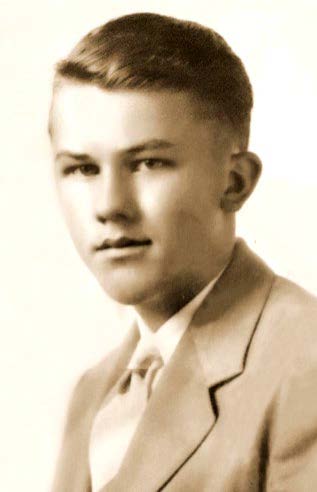
Harold Leonard Johnson at age 16 from his high school portrait
Cadet Harold L. Johnson Naval Reserve V-1
Program Enrollee, Lehigh University One of Cranford’s 86
By Don Sweeney, research by Stu Rosenthal,
military guidance by Vic Bary and editing by Janet Ashnault.
As we begin the process of selecting the next name from those engraved on our town’s memorial tablets and once again prepare to tell the story of one of our 86, we discover stark differences between the circumstances in which these servicemen lost their lives. While many of our stories up to this point told of valiant missions and strategic battles, with details that would make for a thrilling war movie, some of the men on our list lost their lives in much quieter situations. Considering each of their contributions to the war effort of their era, the lives of those that died in non-combat situations were no less important, nor their actions less patriotic than any of our Cranford 86. The loss to their families was certainly just as difficult to bear. It is noted, that in American wars before WWII, more lives were lost in situations that did not involve combat than in those that did.
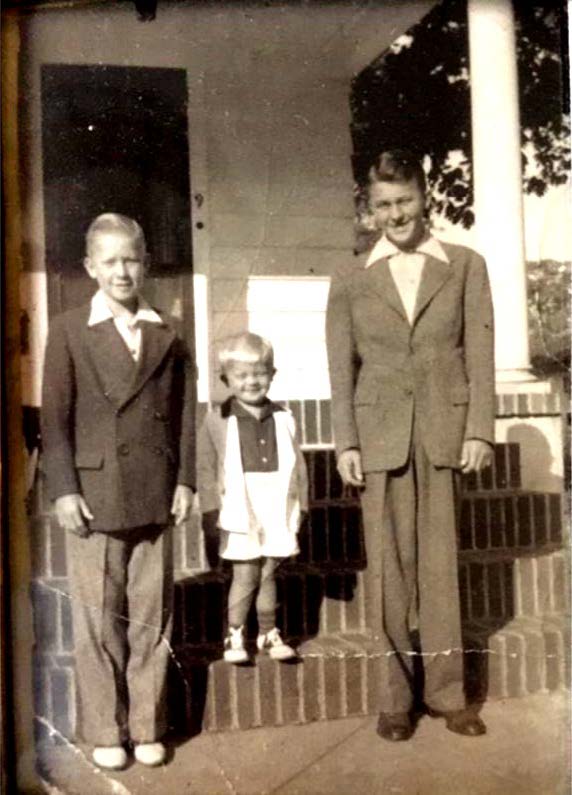
On the porch of their home at 9 Herning Ave. the Johnson boys pose for the only known photo of the three brothers together. From left to right Robert 11, Edward 3, and Harold 15.
The story of Harold Leonard Johnson of 9 Herning Avenue tells of a young man who lost his life while in the service of our country. In U.S. war casualty statistics, his cause of death would be listed simply as “other”. Our goal is to bring a little more of his short life to light and to expand upon the brief passages that we found in a manila folder at the Cranford Historical Society.
After attending Sherman School on Lincoln Avenue, Harold Johnson moved on to the newly constructed Cranford High School on West End Place. It was September of 1938 and we would imagine it was quite a thrill to be one of the first students to attend classes in the new school building. The German invasion of Poland, that began WWII wasn’t to happen for another year. No thought of a war was in anyone’s mind. It was a tranquil time in America. But, it was “The Day of Infamy”, that struck on December 7th of Harold’s senior year at Cranford High School, that changed everything. While most of the boys, and some of the girls, would choose to sign up immediately after graduation, a few would not even wait that long. At the time of the Pearl Harbor attack, Harold was an advanced student of mathematics and science. He had already applied and been accepted to Lehigh University in Bethlehem Pennsylvania, one of America’s elite engineering universities. He was planning to study chemical and electrical engineering and in August of 1942, Harold left his home in Cranford, bound for college.
In November of 1942, Lehigh University was visited by enrollment representatives from the Navy’s highly selective V-1 program. It was then, after just three months at Lehigh, that Harold Johnson seemed to have rethought his plans for the future. Perhaps influenced by the Navy’s recruitment effort (see photo of enrollment poster), Harold enlisted into the program, with plans of possibly becoming an aviator. Only applicants of the highest intellect and physical abilities are even considered. The V-1 program’s schedule of development was normally two years in length. But at this point in our rapidly escalating war involvement, programs were being intensified and shortened to supply the urgent needs of the dual fronts of battle. We located a recruitment brochure from the era for the Naval V-1 program at Lehigh University. (See the link at Cranford86.org). It painted a picture of the honor and privilege that came along with the receipt of Navy Flyers’ Wings, which was something that was beyond the dreams of most young men. This was undoubtedly an exciting time in Harold’s life and perhaps a little terrifying, as he was only 17 years old.
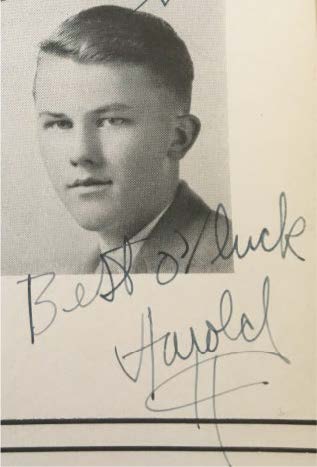
Harold’s signature in the 1942 Cranford HS yearbook.
In the largest national response to support a war effort in U.S. history, every American would make sacrifices to supply the needs of our Armed Forces. Nearly every factory would now serve the war effort. Auto manufacturing was halted and retooled to manufacture aircraft; clothing manufacturers now produced uniforms; even a merry-go-round factory was converted to make gun turrets. Any consumer item that was needed for the war effort was rationed to the American civilian population. Each family, for instance, was limited to 3 gallons of gasoline a week, and nylon, once used for lady’s hosiery, was now only used for parachutes. America was “all in” to support the war effort.
What is not as commonly recognized is that our network of higher education was also converted to train soldiers and officers in specific skills needed to man the engineering marvels that were being turned out of our factories at incredible rates. From Ivy League universities to local junior colleges, nearly all schools were focused on training America’s young military minds. The responsibility of stopping the forces of tyranny and fascism that had threatened freedom for all the world’s inhabitants was so strongly felt, that service to country was expected, and given without hesitation. While many speak of America’s ability to create record amounts of planes, ships and armored vehicles, others would say the real accomplishment that won the war was our ability to hone the minds and bodies of our American youth into the finest fighting force in American history.
We found a speech made by the Harvard University Provost Paul H. Buck which summarized the role of college students leading up to the war. Buck stated clearly the wartime educational philosophy at Harvard, “Obviously your first responsibility is to prepare yourself for usefulness in the war effort. College men need not be told again that they have no right to be in college unless they have planned their program in the light of participation in the war. We firmly believe that every physically qualified man of college age should be trained for the Armed Services unless specifically assigned to other work by an appropriate federal agency.” Civilian enrollment in America’s colleges at the time was below 10%. Again, we were all in.
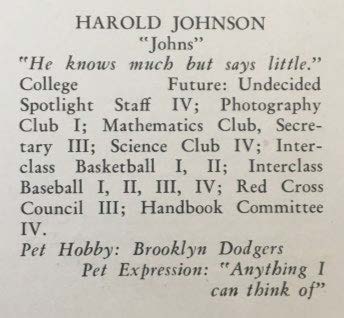
Note the quote under his portrait, “He knows much but says little”
Harold returned home to Cranford for a one-week mid-semester break in January of 1943, only to return to Cranford again on February 12th with an unexplained high fever. Cranford 86 researcher Stu Rosenthal was able to find Harold’s youngest brother Edward living in New Providence. Edward remembers his brother’s return to Cranford vividly. He explained that Harold was bedridden and their family physician, Dr. Albert Lewis, made a house call to attend to him. After just one day, Edward remembers an ambulance taking Harold to Elizabeth General Hospital. He was diagnosed with Lymphatic Leukemia. Today it would be called Hodgkin’s Disease. Edward told us that at the time, no successful treatments had been developed to battle the disease. Blood transfusions and radiation were used but were unsuccessful. Harold L. Johnson passed away on the 25th of February 1943, at the age of 18 years and 6 days. He was buried at Evergreen Cemetery in his native Brooklyn with a traditional civilian ceremony.
Shortly after, the family received a letter from the Navy indicating Harold’s advancement into the next step of his training. Because of his untimely death Harold was never able to take that next step, nor fulfill the plans that he had made to serve our country. With his intellect, physical ability and patriotic intentions one can only imagine what an asset he would have been to America’s Armed Forces.
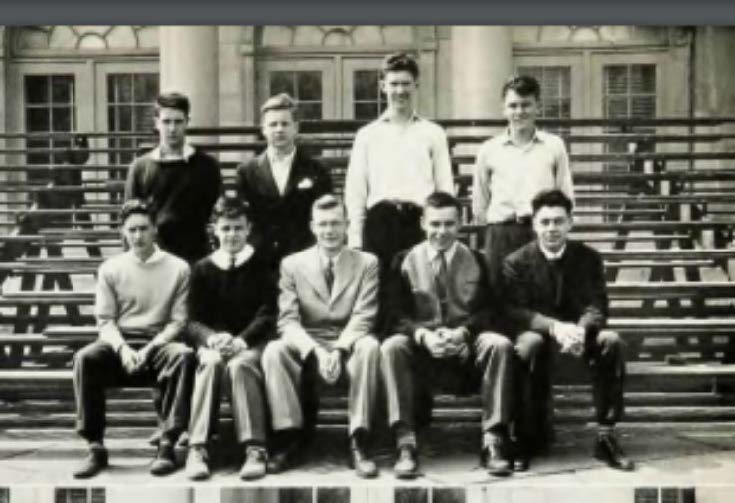
Harold L. Johnson with the members of the Science Club in front of the brand-new Cranford High School.
The Johnsons were a third-generation Scandinavian family with roots in Norway and Sweden. Harold was born on February 19th, 1925 at the Midwood Sanitarium, while the family was living in Brooklyn, New York. Later they moved to East Orange for three years before settling in Cranford when Harold was six years old. At the time of his passing, Harold had two younger brothers, Robert, age 14 and Edward, age 6. Robert went on to become a Marine and served in Washington D.C. as an honor guard after the war. Edward went on to graduate from The Citadel Military College in South Carolina and served in The US Air Force. His parents, Harold and Astrid, lived in Cranford for 35 years before moving to the Norwood section of Plainfield. Mr. Johnson was a Columbia Graduate and a stockbroker at the Faulkner, Dawkins and Sullivan Brokerage firm in New York City. The Johnsons were active members of Calvary Lutheran Church on the corner of Eastman Avenue and Holly Street. Mrs. Johnson was the first president of The Lutheran Woman’s Association there.
Harold was known to his friends as “Johns”. His passion in life was baseball. While he did not play on the varsity team, he was active in all four years in high school in the intramural league. He and his dad were die-hard Brooklyn Dodgers fans. Harold was an active student, a member of the Mathematics Club; the Science Club; the Cranford High School Newspaper (Spotlight); the Red Cross Council; the Handbook Committee and the Photography Club.
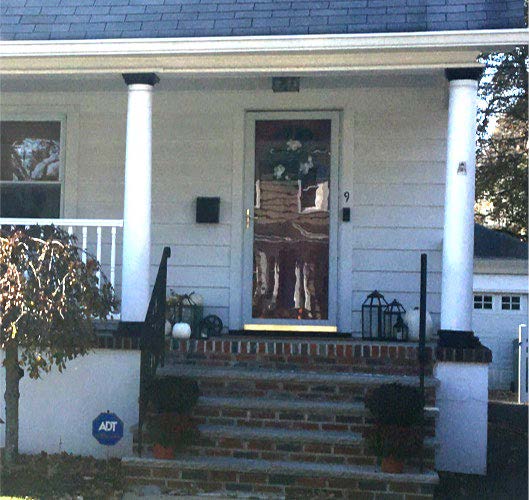
Then and now. Current day photo of the porch of 9 Herning Avenue. It is largely as it was in 1936.
Much of the information used to tell his story was taken from a letter by Astrid Johnson, Harold’s Gold Star mother, written three years after Harold’s death.
Young Harold Johnson voluntarily changed his path in life to serve our country at a very volatile time in history. It was an act of bravery and patriotism and for this action he is deserving of our appreciation and respect. Please join members of the Johnson family when they return to Cranford in 2020 for the dedication of Harold’s banner at the ceremony that will follow the 99th Cranford Memorial Day Parade.
Thank you to John Bolls of Harold Johnson Place for sponsoring this serviceman’s banner and calling our attention to the Harold Johnson story.
We invite you to view all the profiles that have so far been created at Cranford86.org. There is still quite a way to go before we reach our goal of putting a face and a story to each of our Cranford 86 and we reach out to the public for assistance. If you have any information about any of our heroes or would like to sponsor an upcoming banner or simply would like to donate to support our project, please contact us at info@cranford86.org. Follow us on Facebook at “Cranford86”.
Link to 16-page V-1 recruitment flier
http://uss-bennington.org/pics/phz-How_2_Win_Wings.pdf
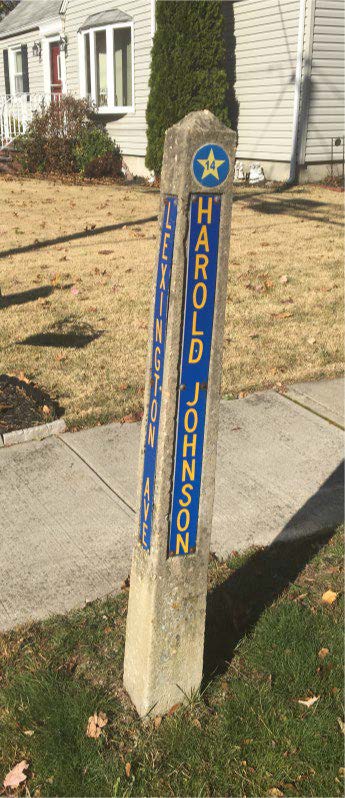
In Indian Village, between the streets named for Alan Okell and Roger Norton, you will find Harold Johnson Place. 57 men from Cranford lost their lives while serving their country in WW2, 5 had streets named in their honor. 15 Cranford men were lost in WW1, 9 streets are named after them. The gold stars on each of the street signs are numbered 1-14.
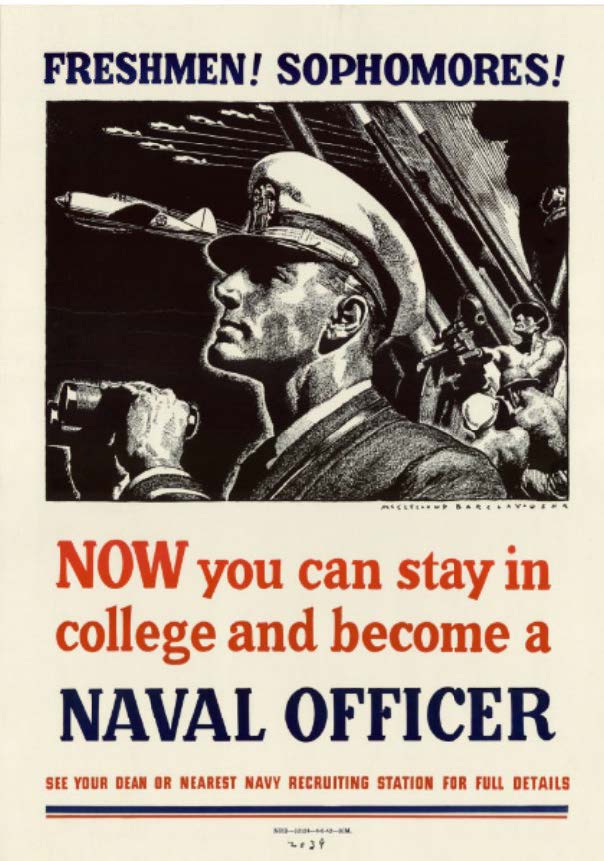
This is the recruitment flier that was posted around the Lehigh campus in the fall of 1942. It may have caught Harold’s eye and lead him to enlist in the program.
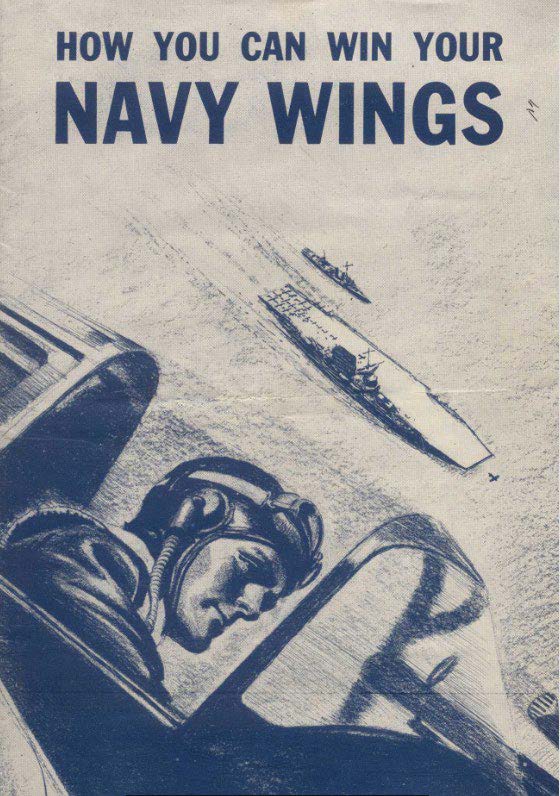
The cover of the 16 page recruitment flier that told of the prestige associated with becoming a Naval aviator.
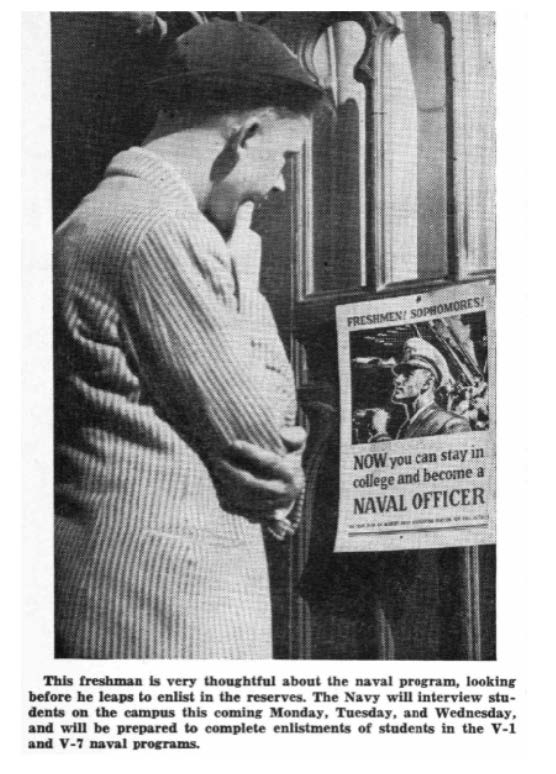
This clipping from the Lehigh University newspaper, The Brown and White, shows an unidentified freshman in the fall of 1942, studying the V-1 recruitment flier. We were unsuccessful in obtaining definite confirmation of whether or not this could be a photo of our Harold. However, comparing the visible features of the freshman against Harold’s high school yearbook photo, we thought there was a good chance that it could be Harold Johnson.
